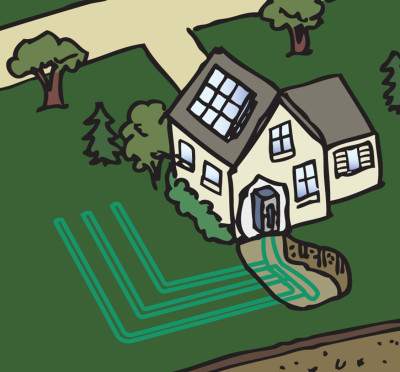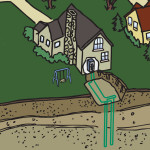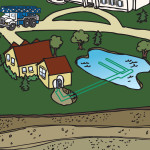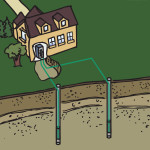Geothermal systems
Geothermal or ground source heat pumps (GSHPs) use the earth’s relatively constant temperature to heat or cool an indoor pool, home or business. This system typically uses the earth’s crust as a thermal mass from which constant energy can be drawn. As the earth is heated by solar energy, a properly designed and installed geothermal system has little or no overall earth temperature impact to the area in which it is installed.
This technology, also known as geo exchange or ground source systems, comprises two major components; the heat pump and the ground loop. The heat pump, simply defined, has a compressor and two heat exchangers and is installed in the building. One is connected to the ground to absorb or reject heat, while the second heat exchanger is connected to a load to transfer heat to a load process (i.e. space or pool water heating). The compressor acts as a transfer agent between the two heat exchangers. It takes heat from the heat exchanger that requires heating or cooling and transfers it to the other side via the refrigeration cycle inherent in the heat pump.
The compressor takes heat from the heat exchanger that requires heating or cooling and transfers it to the other side through the use of the refrigeration cycle inherent in the heat pump. The second component is the ground source heat exchanger, which can be implemented in several different ways:
Horizontal loops
 This is the most common type of ground source heat exchanger. Horizontal loops are commonly used in rural areas due to the land space needed for installation. An excavator will dig several trenches, roughly 1.8-m (6-ft) deep and 91-m (300-ft) long, where geothermal piping is placed. The trench is then backfilled with the same soil.
This is the most common type of ground source heat exchanger. Horizontal loops are commonly used in rural areas due to the land space needed for installation. An excavator will dig several trenches, roughly 1.8-m (6-ft) deep and 91-m (300-ft) long, where geothermal piping is placed. The trench is then backfilled with the same soil.
Vertical loops
 Vertical loops are primarily used in urban areas, as they require little land space for installation. A specially designed geothermal drilling rig bores vertical holes into the ground, each ranging from 55- to 165-m (180- to 540-ft) deep. Geothermal pipe is inserted in each vertical bore and the holes are filled with bentonite grout.
Vertical loops are primarily used in urban areas, as they require little land space for installation. A specially designed geothermal drilling rig bores vertical holes into the ground, each ranging from 55- to 165-m (180- to 540-ft) deep. Geothermal pipe is inserted in each vertical bore and the holes are filled with bentonite grout.
Pond or lake loops
 On properties that have a nearby lake or an appropriately-sized pond (at least 2.4 m [8 ft] deep), a loop system can be submerged to rest on the lake/pond bed. A single trench is excavated from the home to the water, and typically, two geothermal pipes are inserted. These two pipes connect to the submerged loop system, which comprise several geothermal pipes.
On properties that have a nearby lake or an appropriately-sized pond (at least 2.4 m [8 ft] deep), a loop system can be submerged to rest on the lake/pond bed. A single trench is excavated from the home to the water, and typically, two geothermal pipes are inserted. These two pipes connect to the submerged loop system, which comprise several geothermal pipes.
Open loops
 Open loops are commonly used on rural properties that have existing high-capacity water wells. Ground water is drawn from an aquifer through a supply well and pumped into the heat pump, while discharged water from the pump is redirected into a second well and back into the same aquifer.
Open loops are commonly used on rural properties that have existing high-capacity water wells. Ground water is drawn from an aquifer through a supply well and pumped into the heat pump, while discharged water from the pump is redirected into a second well and back into the same aquifer.






